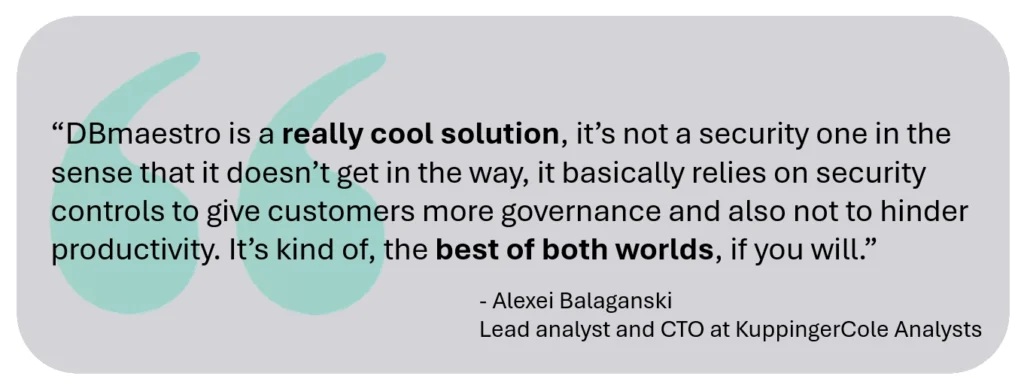As cloud adoption accelerates, so does the complexity of securing cloud environments. Cloud Security Posture Management (CSPM) has emerged as a cornerstone of cloud security, enabling organizations to identify and remediate misconfigurations and vulnerabilities in cloud infrastructure. However, while CSPM tools like AWS Security Hub, Microsoft Defender for Cloud, and Check Point CloudGuard excel at managing risks in cloud services and applications, they often lack deep integration with databases and database-specific workflows.
This gap can be a critical blind spot, as databases house the crown jewels of most organizations: sensitive data. Misconfigurations and risky database changes can lead to breaches, regulatory violations, and reputational damage. By embedding Database DevSecOps platforms like DBmaestro into existing CSPM tools and application DevOps platforms, organizations can achieve a 360-degree view of corporate risk. This article explores how DBmaestro enhances CSPM capabilities by extending their reach into the database layer, enabling proactive risk detection and comprehensive governance.
The Role and Importance of CSPM
CSPM tools automate the detection of misconfigurations, policy violations, and compliance gaps in cloud environments. They provide ongoing monitoring and remediation for cloud-native infrastructure, helping organizations:
- Ensure Compliance: Align with frameworks like GDPR, HIPAA, PCI DSS, and SOC 2.
- Prevent Misconfigurations: Reduce the risk of accidental exposure due to errors in storage, networking, or access controls.
- Detect Threats: Identify potential vulnerabilities and breaches before they can be exploited.
The Limitations of CSPM for Databases
Despite their strengths, CSPM tools have historically focused on infrastructure-level and application-level risks. Databases, however, present a unique set of challenges:
- Dynamic Changes: In fast-paced DevOps environments, database schemas are frequently updated. Without visibility into these changes, CSPM tools may miss risks introduced during development.
- Data Sensitivity: Unlike application misconfigurations, database missteps can lead directly to data exposure or corruption.
- Compliance Complexity: Regulations often have database-specific requirements, such as encryption, auditing, and role-based access controls.
Without deep database integration, CSPM tools may flag application-level risks but fail to address equally critical database vulnerabilities.
Enter DBmaestro: Extending CSPM into Database DevSecOps
DBmaestro bridges the gap between CSPM tools and database environments by embedding Database DevSecOps capabilities into application DevOps workflows. By integrating with tools like Jira, Jenkins, GitLab, GitHub, and CircleCI, DBmaestro extends the proactive risk detection capabilities of CSPM tools to include databases and their change management processes.
Here’s how DBmaestro enhances CSPM:
- Proactive Risk Detection for Databases
While CSPM tools excel at identifying risks in application code and infrastructure, DBmaestro adds database-level scanning for:
- Schema misconfigurations.
- Unauthorized database changes.
- Poorly configured access controls.
For example, DBmaestro can identify when a schema change introduces a new attack vector, such as an overly permissive user role or clear text passwords. By surfacing these risks alongside application vulnerabilities, CSPM tools deliver a more holistic view of security.
- Seamless Integration with Existing Platforms
DBmaestro integrates directly into DevOps platforms and CI/CD pipelines, enabling database risks to be managed alongside application development. For instance:
- Jenkins Pipelines: DBmaestro scans database changes during build and deployment phases, ensuring that no misconfigurations are introduced into production.
- GitLab and GitHub Actions: As developers commit changes, DBmaestro validates database scripts against security policies.
- Jira Integration: Database-related tasks can be automatically tracked as issues within Jira, aligning database governance with existing issue management workflows.
- 360-Degree View of Corporate Risk
By embedding database security into the same ecosystem as CSPM tools, DBmaestro provides a unified view of risk across the entire application stack. Organizations can:
- Correlate application and database risks in a single pane of glass.
- Monitor compliance across both applications and databases in real time.
Use Case: Enhancing CSPM with DBmaestro
Consider a retail company using a multi-cloud environment with CSPM tools like AWS Security Hub and Microsoft Defender for Cloud. These tools monitor application-level risks but lack visibility into database changes. Here’s how DBmaestro transforms their security posture:
- Pipeline Integration:
- Developers push code changes via GitLab, including updates to the database schema.
- DBmaestro scans the schema changes during the CI/CD process, identifying a misconfigured user role that grants excessive privileges.
- Risk Correlation:
- AWS Security Hub detects an overly permissive IAM policy on the application side.
- DBmaestro highlights that this policy aligns with a risky database configuration, tagging a high-priority risk in Jira or Gitlab etc.
- Proactive Remediation:
- Developers receive actionable feedback directly within their CI/CD tools, enabling them to fix the database issue before deployment.
- Security teams view a consolidated dashboard that includes both application and database risks, streamlining compliance reporting.
Why CISOs Should Prioritize Database DevSecOps
For CISOs and risk management leaders, the integration of database security into CSPM workflows is a game-changer. Here’s why:
- Closing the Visibility Gap:
- Databases are often overlooked in cloud security strategies, yet they’re the most targeted assets in breaches.
- DBmaestro ensures that database risks are surfaced and addressed alongside application and infrastructure risks.
- Compliance Simplification:
- Regulations like GDPR, PCI DSS, and HIPAA require strict database controls.
- By automating compliance checks for databases, DBmaestro reduces audit complexity and ensures continuous adherence.
- Enhanced Risk Correlation:
- With DBmaestro, CSPM tools can correlate risks across the full stack, enabling better prioritization and remediation.
- Proactive Governance:
- DBmaestro’s integration with DevOps platforms ensures that security is addressed early in the development lifecycle, reducing the cost and impact of vulnerabilities.
The Future of CSPM and Database DevSecOps
As cloud environments grow more complex, the convergence of CSPM and Database DevSecOps is inevitable. Organizations must adopt tools that can:
- Integrate Seamlessly: Security solutions must work across applications, infrastructure, and databases without adding friction.
- Shift Left: Risks must be detected and remediated earlier in the development lifecycle.
- Provide Holistic Visibility: Security teams need a unified view of risks across all layers of the stack.
DBmaestro is uniquely positioned to enable this convergence. By embedding database security into CSPM tools and DevOps platforms, it provides the comprehensive governance needed to secure modern cloud environments.
Conclusion
Cloud Security Posture Management has transformed how organizations secure their cloud infrastructure, but its true potential is unlocked when extended to the database layer. DBmaestro enhances CSPM tools like AWS Security Hub, Microsoft Defender for Cloud, and Check Point CloudGuard by embedding database DevSecOps capabilities into CI/CD pipelines and DevOps workflows. This integration enables proactive risk detection and provides a holistic view of corporate risk, ensuring that databases—the foundation of most organizations—are no longer a blind spot.
For CISOs, the message is clear: securing databases is just as critical as securing applications and infrastructure. By adopting DBmaestro, organizations can not only strengthen their security posture but also streamline compliance and governance, achieving true end-to-end cloud security.








